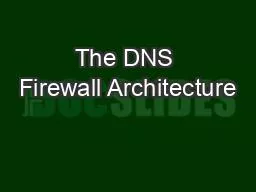

At Virginia Tech About Me Brad Tilley bradvtedu Formerly ISO at Radford University Currently Sr Security Architect at VT Education Georgia Tech Virginia Tech Various other technology positions outside of ID: 810194
Download The PPT/PDF document "The DNS Firewall Architecture" is the property of its rightful owner. Permission is granted to download and print the materials on this web site for personal, non-commercial use only, and to display it on your personal computer provided you do not modify the materials and that you retain all copyright notices contained in the materials. By downloading content from our website, you accept the terms of this agreement.
Slide1
The DNS Firewall Architecture
At Virginia Tech
Slide2About Me
Brad Tilley -
brad@vt.edu
Formerly - ISO at Radford University.
Currently - Sr. Security Architect at VT.
Education - Georgia Tech, Virginia Tech.
Various other technology positions outside of
DoIT
over last 20 years.
Slide3Presentation Outline
What is a DNS Firewall (aka RPZ)
The Client View
Configuration
Redirects
Exemptions
The Infrastructure View
Partner with Network Services
Interoperate with decentral departments (separate DNS)
The Technology View
DB, API and feeds
The Future & Lessons Learned
Slide4What is a DNS Firewall?
Slide5What is a DNS Firewall?
Slide6No Really… What is a DNS Firewall?
Also known as Response Policy Zone (RPZ).
A mechanism in the DNS which allows recursive resolvers to customize responses (tell lies) for certain zones.
First released in 2010 in BIND by Paul
Vixie
/ISC.
It is an open and vendor-neutral standard.
Goal is to protect clients from malicious domains.
VT has been experimenting with RPZ since 2012.
Slide7Timetable
No off-campus
2/25/19 – ISB, RB14 DHCP hosts (COMPLETE)
3/4/19 –
Resnet
(static, wireless) DHCP hosts
3/7/19 – ITSO/NI&S deployment assessment
3/11-31/19 – final rollout for rest of campus DHCP
Optional – users can configure their static hosts manually anytime
Slide8The Client View - Configuration
VT Clients use the VT RPZ blocking enabled recursive resolvers.
nyet.iso.vt.edu – 198.82.247.39
nein.iso.vt.edu - 198.82.247.111
nope.iso.vt.edu – 198.82.247.69
Currently only available from vt.edu address space.
All VT DNS Recursive Resolvers transfer and log the RPZ.
milo.cns.vt.edu - 198.82.247.98
jeru.cns.vt.edu - 198.82.247.66
yardbird.cns.vt.edu – 198.82.247.34
Only
nyet
,
nein
and nope tell lies.
Slide9Are Malware Callbacks a Problem?
Slide10Client View
Redirect
Slide11Redirect Landing Page - Web
Slide12The Infrastructure View
Mostly BIND on Unix servers Centrally
Two authoritative
Three recursive resolvers
Few Dozen MS Active Directory DNS Systems
Centrally and out in depts
Few Remaining Open Recursive Resolvers
This is due to abuse (DDoS)
The ones that remain rate limit or restrict access
We’re mostly 1
st
generation DNS (BIND, C, Unix)
This is a 30+ year old technology stack
Slide13The Servers
Slide14Working with campus partners
NI&S maintains the DNS servers and process.
ITSO maintains security feeds and master RPZ DNS server.
Other campus depts (with own DNS) may:
Forward queries to
nyet
,
nein
and nope.
Transfer the BL zone from the ITSO.
Slide15The Technology View
Goal is high-quality blocks with low false-positive rate.
Ultimately we want to prevent infection, phishing, drive-
bys
.
Keep popular domains (google,
facebook
, etc. off the block list).
Get as many bad domains as possible onto the block list.
Rotate out stale data so as not to punish innocent sites used in attacks.
Would like to learn from other schools who have thought about these issues. What do others do?
Slide16The RPZ Database
Goals
Age out domains
Protect Popular domains
If Seven Days Have Passed Since Last Report
Remove from DB
Unless SOC Analyst Added the domain
Serverless SQLite DB Engine
Simple, Compact and Fast
Slide17The RPZ API
Goals
Authentication
Attribution
Remote Access
Automation/Integration with other NetSec Assets
Technology
Written in Go
Runs as normal user
Manipulates RPZ DB BL
Isolated from BIND
Slide18API - Check
Slide19API - Add
Slide20Dnsdiff
Written in Go
Monitors RPZ DB for change
Upon detecting change, reloads Block List zone in BIND
Won’t be needed when we switch to
CoreDNS
as it does this itself
Slide21The Feed Sources
Automated
Malware Domains
REN-ISAC SES
Ransomware Tracker
Zeus Tracker
Maybe NOD soon (working on this)
Manual/API
FireEye Appliances
Bro
We’d like to learn about other high-quality sources.
What do others do?
Slide22The Future
Move from BIND to 3
rd
Generation DNS (
CoreDNS
)
BIND has been around for long time (30+ years, C)
PowerDNS
would be 2
nd
generation DNS (DB backed, C++)
CoreDNS
is 3
rd
generation (cloud and container first, Go)
Move everything into Docker and run in AWS
Obtain more and better quality feeds
Continue to refine and perfect logic and stats
Slide23Lessons Learned
It’s worth the effort and cost
Has prevented compromises
Popular with campus community
Spend more time upfront thinking
How do we collect/visualize stats?
How do we measure effectiveness?
How do we mine the redirect data to find other issues?
How do we integrate with other
netsec
assets?
Be prepared to deal with detractors
The intent is NOT to spy on DNS queries
It’s just another layer
Slide24Conclusion
Open Forum/questions